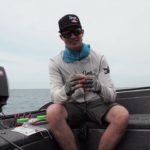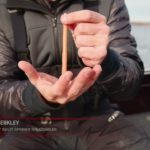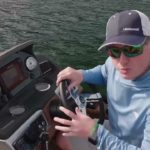Walleye Spinners 101
Hall of Fame Angler and full-time “Biter” Keith Kavajecz offers the novice and the veteran walleye angler alike, a crash course in the basics of spinners for walleyes.
 Some call it a spinner, some call it a crawler harness, but what ever you call it there’s no doubt that it catches walleyes anywhere they swim. In its basic form it consists of a three to six foot snell of 10 to 14# test monofilament, half a dozen or so colored beads, a blade and clevis, and a business end comprised of one to three hooks. By its self it really isn’t that impressive, but dress the hooks with a juicy nightcrawler, minnow, leech or even a plastic imitation of the afore mentioned, then add a weighting system to take the package to the fish zone, and it becomes a deadly walleye catching presentation.
Some call it a spinner, some call it a crawler harness, but what ever you call it there’s no doubt that it catches walleyes anywhere they swim. In its basic form it consists of a three to six foot snell of 10 to 14# test monofilament, half a dozen or so colored beads, a blade and clevis, and a business end comprised of one to three hooks. By its self it really isn’t that impressive, but dress the hooks with a juicy nightcrawler, minnow, leech or even a plastic imitation of the afore mentioned, then add a weighting system to take the package to the fish zone, and it becomes a deadly walleye catching presentation.
Spinners are by no means a new fad on the walleye scene. They’ve been doing what they do best for decades. However, this is one category of walleye lure that has seen a surge in both design innovation and popularity over the past couple of years. Part of the evolution comes from the fact that spinners can be as diverse as the anglers that use them. Variations in blade sizes, shapes and finishes, bead size and color, line size and material, as well as types and number of hooks used all play a factor in a spinner’s effectiveness on any given day. All that experimentation however, has spawned some interesting trends in spinner components and techniques that make these presentations more productive than ever.
Basically the difference in the two are the size of the blade, and the hook choices. For spinners used on structure, “smaller is better”. Since the system will be fished close to the bottom, lighter weight components are used to prevent dragging and snagging on the bottom. The most popular blade size is a #3, although sizes all the way down to #0 are employed. The round Colorado and the more elongated Indiana style blades get the most utilization. Hook choice for structure spinners usually falls into the category of a live bait style hook, with a #4 size being most common. While some spinners are tied with 3 hooks in succession for use with crawlers, more and more anglers are going to a two hook harness with the hooks spread apart a bit more instead. This cuts down on the weight of the spinner, and gives the crawler better action through the water. When baiting the spinner with either a minnow or a leech, use a single hook spinner. Utilizing red hooks like Mustad’s “Big Red” Beak Bait Hook are a popular trend, as the hint of red provided by the hooks become an added attraction for walleyes.
Open water spinners, while similar to the structure spinners, are generally bigger. They’re designed to catch a walleye’s attention in the vast open water areas where they suspend and roam like wolf packs, on waters where the average fish tends to be much bigger than the majority of the fish being targeted on structure. Blade sizes will run in the #4 to #6 range with the old adage “Bigger is Better” holding true more often than not. Bigger hooks are also the norm, with one popular configuration being a #1 bait hook at the head of the spinner with a #6 treble hook at the tail end. The treble hook gives the obvious advantage of more hooking power, and since the lure is not normally being fished near the bottom, snags are rarely a problem.
 The innovations in spinners have been numerous the past few years. Blades have always been a source of evolution with a myriad of colors and finishes hitting the market over the years. The biggest decision in the past was whether to go for the color attraction of painted blades, or the flash of a metallic finish when choosing the blade. Holographic finishes combine color and flash, and have become the dominant patterns on the walleye tournament trails. We worked very closely with the lure designers at Bass Pro Shops to develop the Walleye Angler XPS Spinner Blades that feature hologram style finishes, but we did not stop there. XPS Spacer BodyWe also developed a one-piece spinner body called the Walleye Angler XPS Blade Spacer. This body replaces the use of conventional beads and makes tying your own spinners much easier. Now you simply slide on one of the Blade Spacers, and you’re good to go. These bodies come in 2 sizes (small for structure spinners and large for open water applications), and feature eye catching hologram finishes similar to the blades for even more attraction.
The innovations in spinners have been numerous the past few years. Blades have always been a source of evolution with a myriad of colors and finishes hitting the market over the years. The biggest decision in the past was whether to go for the color attraction of painted blades, or the flash of a metallic finish when choosing the blade. Holographic finishes combine color and flash, and have become the dominant patterns on the walleye tournament trails. We worked very closely with the lure designers at Bass Pro Shops to develop the Walleye Angler XPS Spinner Blades that feature hologram style finishes, but we did not stop there. XPS Spacer BodyWe also developed a one-piece spinner body called the Walleye Angler XPS Blade Spacer. This body replaces the use of conventional beads and makes tying your own spinners much easier. Now you simply slide on one of the Blade Spacers, and you’re good to go. These bodies come in 2 sizes (small for structure spinners and large for open water applications), and feature eye catching hologram finishes similar to the blades for even more attraction.
Even the line we use to tie spinners has seen some changes. Many of the anglers on the Professional Walleye Trail have gone to using fluorocarbon lines or leader material on their spinners. Berkley’s Trilene 100% Fluorocarbon is low-stretch for optimum feel, has great abrasion resistance, and is virtually invisible underwater. Since this line is so clear, we’ll often bump up to a heavier pound test than we’d have used in the past. 15 pound test is a popular size for most applications, 20 pound test can be used to up the odds of landing the big one when it bites.
With this “tried and true” technique, and the evolution of new and innovative components, its not hard to see that fishing spinners for walleyes is going to remain one of the deadliest presentations you can hit the water with this season.





